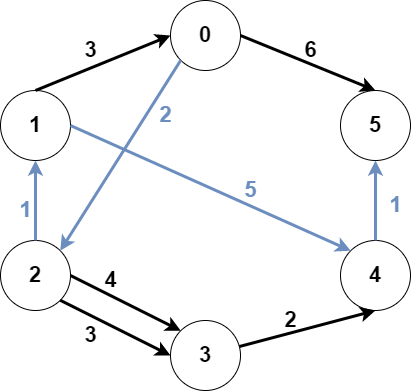Problem
You are given an integer n denoting the number of nodes of a weighted directed graph. The nodes are numbered from 0 to n - 1.
You are also given a 2D integer array edges where edges[i] = [fromi, toi, weighti] denotes that there exists a directed edge from fromi to toi with weight weighti.
Lastly, you are given three distinct integers src1, src2, and dest denoting three distinct nodes of the graph.
Return **the *minimum weight* of a subgraph of the graph such that it is possible to reach** dest from both src1 and src2 via a set of edges of this subgraph. In case such a subgraph does not exist, return -1.
A subgraph is a graph whose vertices and edges are subsets of the original graph. The weight of a subgraph is the sum of weights of its constituent edges.
Example 1:

Input: n = 6, edges = [[0,2,2],[0,5,6],[1,0,3],[1,4,5],[2,1,1],[2,3,3],[2,3,4],[3,4,2],[4,5,1]], src1 = 0, src2 = 1, dest = 5
Output: 9
Explanation:
The above figure represents the input graph.
The blue edges represent one of the subgraphs that yield the optimal answer.
Note that the subgraph [[1,0,3],[0,5,6]] also yields the optimal answer. It is not possible to get a subgraph with less weight satisfying all the constraints.
Example 2:

Input: n = 3, edges = [[0,1,1],[2,1,1]], src1 = 0, src2 = 1, dest = 2
Output: -1
Explanation:
The above figure represents the input graph.
It can be seen that there does not exist any path from node 1 to node 2, hence there are no subgraphs satisfying all the constraints.
Constraints:
3 <= n <= 10^50 <= edges.length <= 10^5edges[i].length == 30 <= fromi, toi, src1, src2, dest <= n - 1fromi != toisrc1,src2, anddestare pairwise distinct.1 <= weight[i] <= 10^5
Solution
class Solution {
public long minimumWeight(int n, int[][] edges, int src1, int src2, int dest) {
List<int[]>[] graph = new List[n];
long[][] weight = new long[3][n];
for (int i = 0; i < n; i++) {
for (int j = 0; j < 3; j++) {
weight[j][i] = Long.MAX_VALUE;
}
graph[i] = new ArrayList<>();
}
for (int[] e : edges) {
graph[e[0]].add(new int[] {e[1], e[2]});
}
Queue<Node> queue = new PriorityQueue<>(Comparator.comparingLong(node -> node.weight));
queue.offer(new Node(0, src1, 0));
weight[0][src1] = 0;
queue.offer(new Node(1, src2, 0));
weight[1][src2] = 0;
while (!queue.isEmpty()) {
Node curr = queue.poll();
if (curr.vertex == dest && curr.index == 2) {
return curr.weight;
}
for (int[] next : graph[curr.vertex]) {
if (curr.index == 2 && weight[curr.index][next[0]] > curr.weight + next[1]) {
weight[curr.index][next[0]] = curr.weight + next[1];
queue.offer(new Node(curr.index, next[0], weight[curr.index][next[0]]));
} else if (weight[curr.index][next[0]] > curr.weight + next[1]) {
weight[curr.index][next[0]] = curr.weight + next[1];
queue.offer(new Node(curr.index, next[0], weight[curr.index][next[0]]));
if (weight[curr.index ^ 1][next[0]] != Long.MAX_VALUE
&& weight[curr.index][next[0]] + weight[curr.index ^ 1][next[0]]
< weight[2][next[0]]) {
weight[2][next[0]] =
weight[curr.index][next[0]] + weight[curr.index ^ 1][next[0]];
queue.offer(new Node(2, next[0], weight[2][next[0]]));
}
}
}
}
return -1;
}
private static class Node {
int index;
int vertex;
long weight;
Node(int index, int vertex, long weight) {
this.index = index;
this.vertex = vertex;
this.weight = weight;
}
}
}
Explain:
nope.
Complexity:
- Time complexity : O(n).
- Space complexity : O(n).